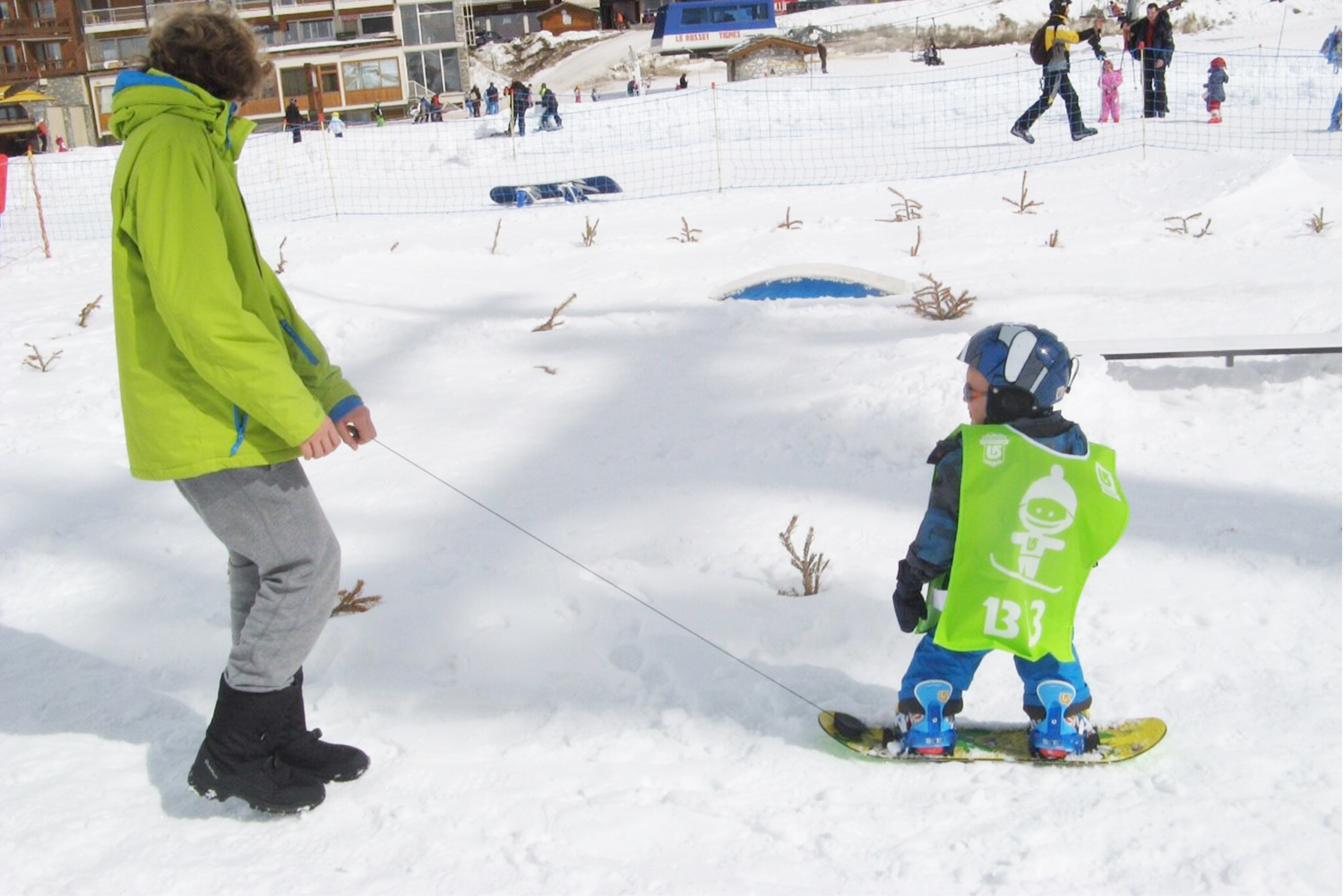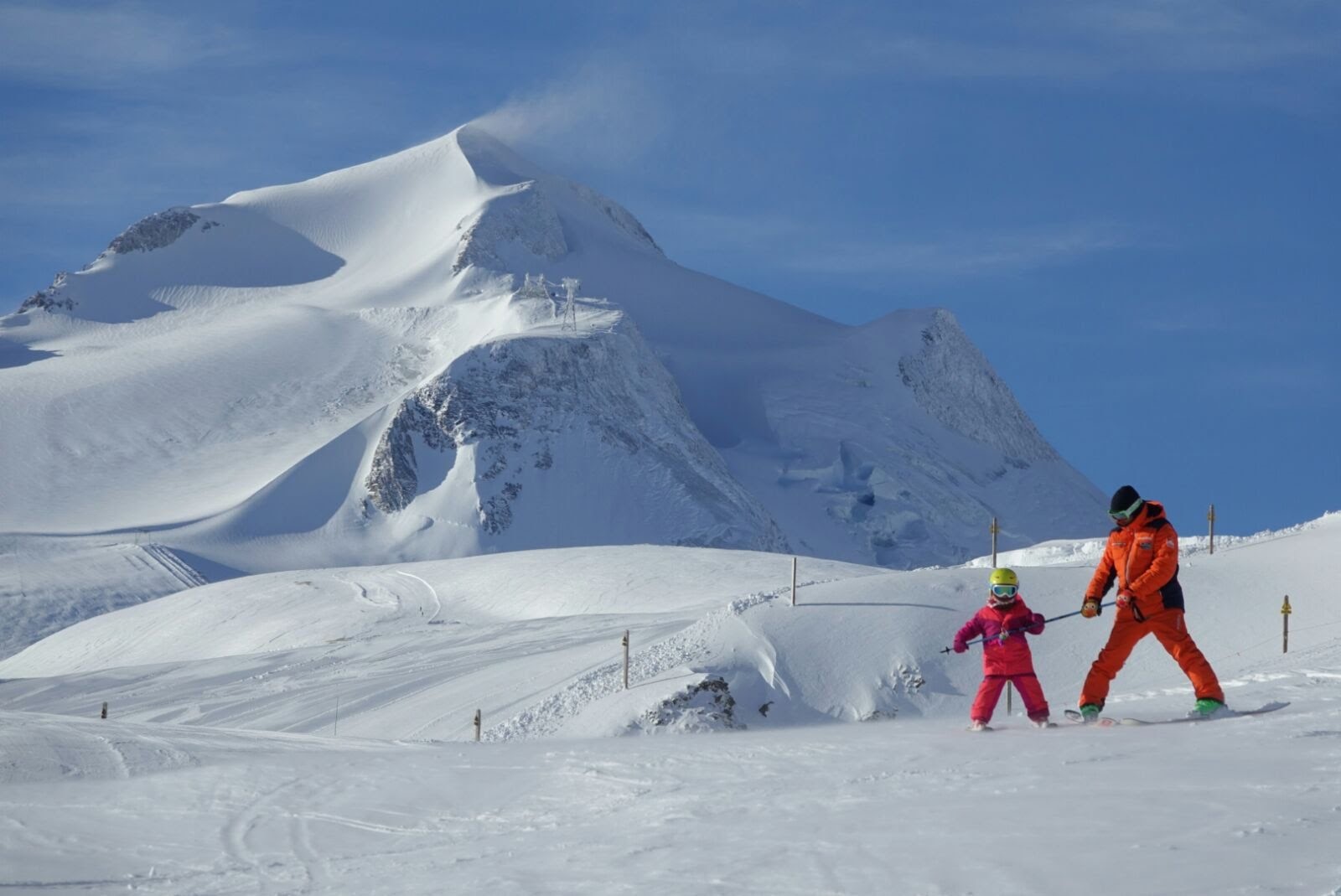
The Rights-and-Wrongs of skiing with young children
Can you go on a skiing holiday with young children? Yes, it’s certainly possible! This section on the “Rights-and-Wrongs” of skiing with young children, with comments from Nathalie Bertholin, Corinne Mermoz, Pierre Espargiliere and Neile Combralier, all ski instructors in Tignes, illustrates this fact.
A child can wear skis from the age of 3 upwards…
RIGHT! There are even some schools that give private lessons to children from the age of 2 and 3 and a half for group lessons. It depends a lot on the child, what he wants, how active he is and, more specifically his feet which need to be big enough to fit children’s ski boots. But you can find hire ski boots that start at size 22/23.
 WHAT ABOUT SNOWBOARDING? SURELY THIS ISN’T SOMETHING THEY SHOULD DO STRAIGHTAWAY?
WHAT ABOUT SNOWBOARDING? SURELY THIS ISN’T SOMETHING THEY SHOULD DO STRAIGHTAWAY?
WRONG! You can put a child on a snowboard from the age of 2 and a half. What’s more it’s a good way to teach him how to get up. That’s reassuring news for all die-hard snowboarders!
However, according to Nathalie Bertholin, it’s something that should be tried as a complement to skiing. For many, it’s best to wait until they’re 6 to 8 years old to prevent exposure to asymmetrical sports at too young an age, but if your child is very insistent, there’s nothing to stop them from trying.
Children’s ski lessons are really just a form of daycare...
WRONG! Ski lessons help set clear objectives for your little darlings!
Your child will experience the thrill of skiing and learn how to snow-plough by playing fun games. But in addition, your child will also learn to improve their concentration, develop their motorskills and balance. It’s about raising awareness but children learn quickly! Some will attempt their first turns at the end of the week!
“Although family history has a strong influence on performance level, it’s important to encourage everyone to do sport. All children will benefit from the life lessons that sport gives them, irrespective of the level of performance they achieve.”
Nathalie Bertholin
 TAKING A SKI LIFT WITH A YOUNG CHILD IS TOO DIFFICULT...
TAKING A SKI LIFT WITH A YOUNG CHILD IS TOO DIFFICULT...
WRONG! There are special lifts for very young children such as magic carpets or the rope tow....but if using conventional lifts you just need to make sure you offer the correct assistance. Depending on his level, you can put an arm in front of him for support, lift him up a bit to help him sit on the chairlift, shift him back on the seat and help him get down from the chairlift.
Furthermore, the chairlifts are now equipped with a U-block system on the guard rails.
But be careful! These devices are only fitted on one side of the chairlift: always on the side of the slope manager and his hut.
Holding my child between my legs is a good way of teaching him to ski...
WRONG! WRONG! WRONG! DOUBLY WRONG!
If there’s one issue that all ski professionals agree on, it’s this! In addition to being:
- Bad for your back (Yes, the Magazine’s editorial staff are worried about your lower back…), it is
- Dangerous: Firstly, if you fall, you risk falling on top of your child and secondly, you won’t be able to keep your eyes on the skiers around you when you're holding him. Which means there’s a risk of collision (see first point)
- Holding a child between your legs will hinder his progress.
- He will lean back in your arms and adopt bad postural habits that will then become very difficult to correct.
- He won’t support his body by himself, he won’t experience the sensation of sliding, or use the correct muscles to stay upright. The learning process will just take longer.
What’s a good alternative? Once your child can manage on the flat, and can stay upright on a gentle slope before coming to a natural stop, take him alongside you and hold out a pole. In this position, he’ll be able balance, will feel supported and be in control of his own skis!
An additional bit of advice: make sure that the level of difficulty of the slope matches his ability. Stay on easy, specially adapted terrain where he can learn to stop and manage by himself without being afraid. An absolute must... A slope that allows you stop naturally to help avoid scary scenarios.
 “Skiing is an activity that should make your child happy. It must remain fun.“
“Skiing is an activity that should make your child happy. It must remain fun.“
Pierre Espagiliere
 STARTING MY CHILD OFF ON SNOWBLADES IS A PRACTICAL WAY OF LEARNING TO SKI AND JUST AS GOOD AS USING SMALL SKIS...
STARTING MY CHILD OFF ON SNOWBLADES IS A PRACTICAL WAY OF LEARNING TO SKI AND JUST AS GOOD AS USING SMALL SKIS...
WRONG!
Of course, you can’t deny that they’re practical... But après-ski boots won’t provide your child’s feet with as much support as snow boots. Snowblades are for the under 2s or 3s and are just for fun. But when they are learning to ski, they need specially designed skis and boots!
For parents who are worried about boots hurting their little darlings’ toosties, there’s no need to panic! Children’s ski boots are now much better designed. When choosing boots, listen to what your child says: when you try on a pair of ski boots, it’s normal for them to be a bit uncomfortable at first; it’s the same for both children and adults. But in just a few days, the boots will fit him like a glove!
What about the rest of the equipment?
- Skis: Size is important! The ski tip should reach your child’s chin.
- Poles: They don’t need poles until they know how to turn!
When skiing, I should dress my child in the same way as I dress myself...
TRUE!
You dress your child according to the weather, just like adults. Because children move around a lot, you should try to kit them out with breathable clothing to reduce sweat and fleece to protect against the cold. Salopettes are very practical as they prevent the snow from getting in everywhere.
An additional word of advice: avoid all-in-ones... They’re really not practical when you urgently need to go to the loo!
However, there are a few essential items:
- Specially designed gloves! Or rather mittens to protect their fingers from the cold. But CAREFUL about the size. Especially when they're at ski school, as if their mittens are too big they won’t be able to grab anything and won’t get the most out of their day.
- Neck warmer: This small, sensitive area needs to be well protected from the wind and cold!
- Glasses or goggles: Eye protection is essential. Being in the snow, is just like being at sea where eyes are very vulnerable to glare. So we need to look after them by wearing lenses with index 4 protection.
Goggles are much more practical when wearing a helmet. The arms of glasses, worn under a helmet, can be painful for children.
Here’s video proof that you can ski with really young children!
(Copyright: PG Conrardy)
Some additional tips...
1) - Avoid saying “Put your skis parallel”:
With children, the best thing is to use visual language; here are a few examples:
- Instead of "parallel skis" opt for: "straight like French fries/like a Twix bar"
- To help them understand the snow plough, try telling them to "Make a pizza, mountain, Christmas tree, snow groomer or witches hat"
- “Do the same as me“ is also a good example as children do a lot by copying.
2) - “Trust your child! “:
Nathalie Bertholin: “Short goodbyes are best!”
Once your child is on skis and in good hands, it’s time for you to leave and enjoy the snow so that he learns to be confident in a group and with the instructor. By staying with him, you put pressure on him, even if you don’t intend to.
Our advice? : let them get on with it, show that you have confidence in them and regularly check that they're ok by asking: “did you have fun?“
And we guarantee, by the end of the week, he’ll have a bright smile on his face!
And because we can’t resist, here are a few really sweet phrases overheard by instructors:
- I’m making a snow hunter”
- “ Bum-tow” instead of “ski-tow.”
- “My instructor’s beautiful.”
They're irresistible!
 OPEN
OPEN

